Overview
A number of iCIMS' Talent Cloud products leverage searching and reporting, including:
- iCIMS Applicant Tracking
- iCIMS Offer Management
- iCIMS Onboarding
- iCIMS Connect (Legacy CRM)
The iCIMS system's searching and reporting capabilities allow users to search the information stored within standard and custom fields and analyze trends within standard and user-generated reports.
Users can run simple name or ID-based searches with the quick search tool or run standard and ad-hoc searches using the system's powerful full search capabilities.
This article provides an overview of the system's quick search feature, as well as links to relevant articles about full search capabilities. This article also provides a list of popular searches available within the system. If you have been directed to this page from the search form within your system, you may wish to skip to the Full Search section of this article.
Quick Search
iCIMS offers a quick search feature near the right side of the menu bar for users with appropriate search permissions.
This feature allows iCIMS users to seamlessly search for specific Person, Job, or Location profiles by name, system ID, or email address (if applicable) within the system. If enabled, users can also search for specific rooms, talent pools, new hire categories, and events. (Clients who would like to enable the relevant quick search options for their solutions may do so by submitting a case to iCIMS Technical Support.)
To utilize the quick search feature, follow these steps:
-
Review the displayed search type to the left of the quick search text field. If the correct search type is displayed as the label of the button (e.g., if Person is displayed on the button and the search desired is a Person search), skip to step 3 below.
-
Click the dropdown beside the quick search text box. All available options display. Select the desired search type from the list. Only one profile type may be searched at a time.
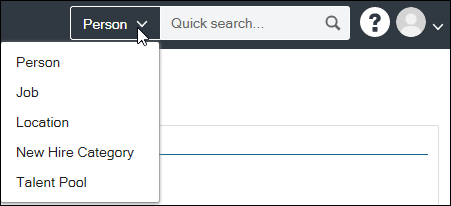
-
Type the desired name, system ID, or email address (if applicable). The system provides autocomplete results once at least two characters are entered.
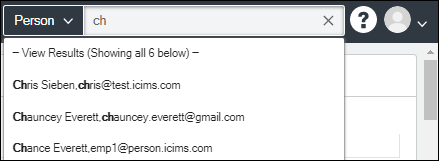
-
Click the desired result to open a specific profile, or click the — View More Results — option or click Enter on your keyboard to launch the full search results view.
- Tip: A Person quick search provides results reflecting all individuals within the system. To search for candidates only, use the full search functionality by navigating to Search > Person > Candidate on the menu bar.
Full Search
If you are new to searching and reporting, review the information below. Then, to learn how to run a search, continue on to the Creating a Job Search article (or Creating a Person Search, if desired).
Introduction to the Search Form
When any full search option is selected, the search screen will display. For example, a Job search (which may be accessed by clicking Search > Job from the menu bar) is shown below.
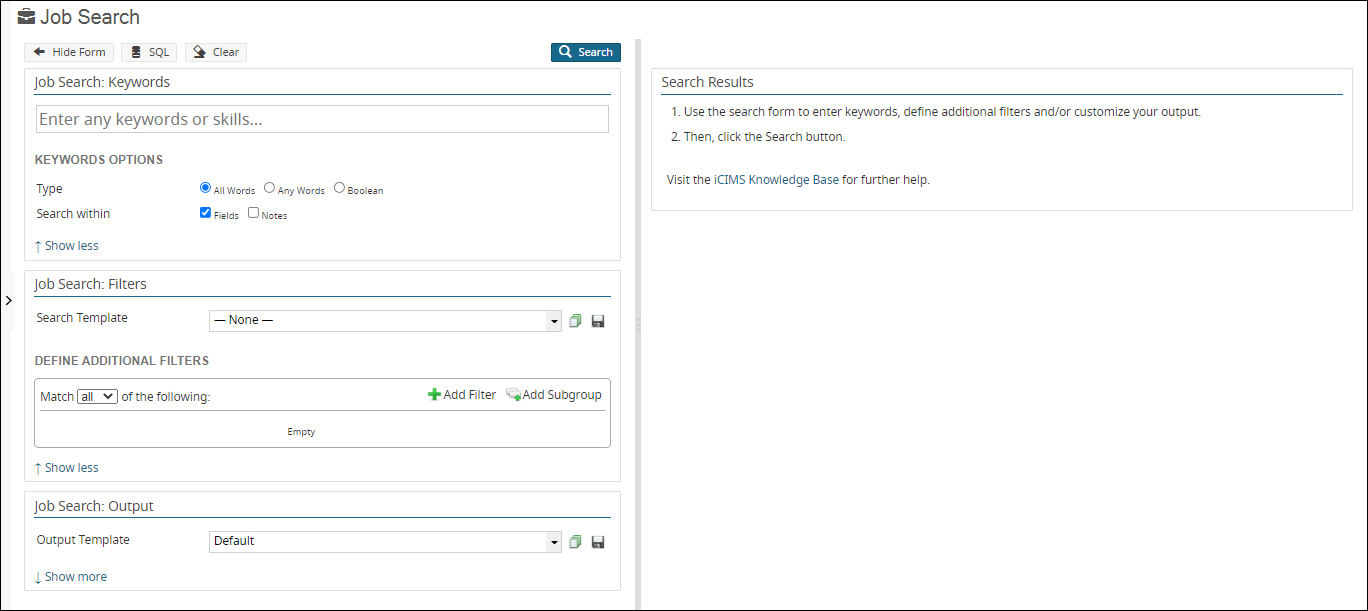
On the left side of the screen, the search form is split into three sections: Keywords, Filters, and Output. The keywords and filters determine which search results you will get; the output section determines how those search results will display.
The right side of the screen will display your search results once you have clicked the Search button. This is your search output, which can be exported in several formats or, depending on the results, viewed as a graph.
Keywords
Keywords are specific words that you wish to search for within a profile. You can enter one keyword or multiple keywords to search; you can also conduct a search without any keywords.
Note: Keywords are limited to 100 characters by default.

By default, the search engine looks for all keywords you enter within profile fields. You can alter this default behavior by changing the Keywords Options described below:
-
Type: All Words: This is the default setting for keyword searches; the search engine will search for all of your keywords within a profile. (For example, if your keywords are marketing coordinator, only job profiles with both of those words will be returned, such as a job titled Senior Coordinator of Marketing.)
-
Type: Any Words: This setting will search for any of your keywords within a profile. (For example, if your keywords are marketing coordinator, job profiles with either marketing or coordinator in them will be returned, such as jobs titled Marketing Manager or Sales Coordinator.)
-
Type: Boolean: This setting will allow you to conduct a keyword search using Boolean operators and wild cards. Refer to the Introduction to Boolean Search article for more information.
-
Type: Text (not shown): This setting is only available in conjunction with Hot Matching. View the Hot Matching Job Candidates article to learn more about Hot Match. Selecting this setting will bypass the default 100 character limit on keywords.
-
Search within: Fields: This is the default setting for keyword searches; the search engine will search for your keywords within fields.
-
Search within: Notes: This setting will search for your keywords within profile notes.
Filters
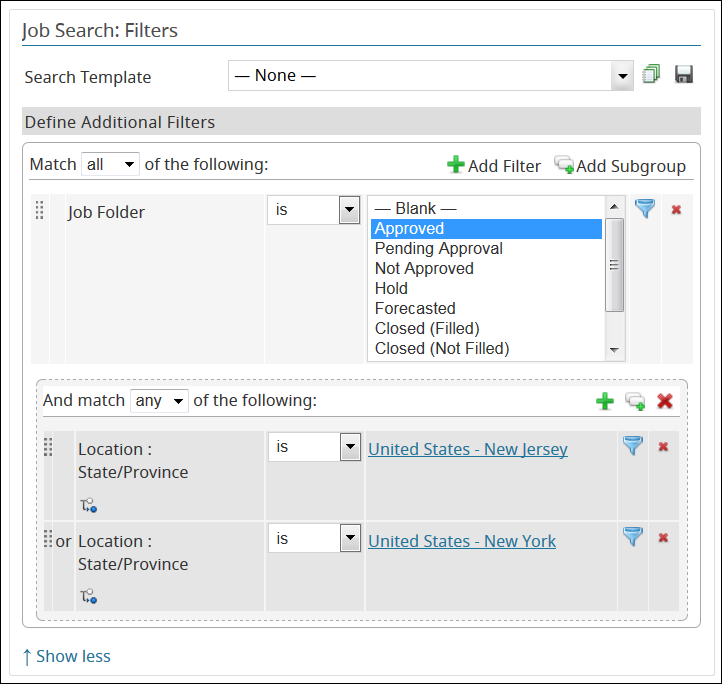
Filters are specifics that your search results must have in order to be returned by the search engine. For example, the filter Location: State/Province...is...United States – New Jersey will return only jobs where the location has been entered as New Jersey; no other jobs will be returned as search results.
Subgroups are used to add AND/OR logic within a filter, such as searching for jobs for which the Job Folder is Approved AND the Job Location is either New Jersey OR New York.
Users can select is or is not as the search operator for filters and subgroups; for text-based searches, users also have the options of contains or does not contain. Filters and subgroups are covered in more detail in the Introduction to Searching & Reporting: Filters & Subgroups article.
Tips:
-
Delete filters or subgroups by clicking the Delete (X) icon to the right of each item.
-
Newly-added filters and subgroups are added to the end of the list. Rearrange the order of the items in the list by clicking the grip icon (the icon with two columns of four grey dots that appears to the left of each row) and dragging the item to the desired location.
Output
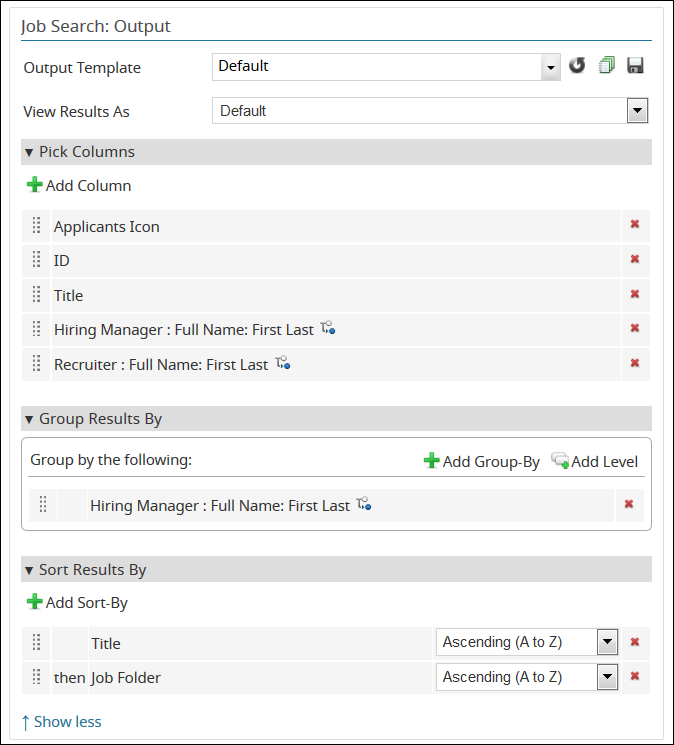
Output is the information that will be returned to you; this section of the search form allows you to specify what information you want returned and how that information will be displayed. Each search type has a default output that will return popular information (such as job title and ID), sorted in a logical way. You can also save an output template or use others' output templates, if you have system permissions to do so.
Columns are the information that is returned in the search; in the example above, the Applicants Icon, Job IDs, Job Titles, Hiring Manager names, and Recruiter names will be returned. Each piece of information about a profile that you want to see in your results should be added as a column.
Possible columns include not just profile fields, but also icons that will allow you to view more information about results (such as the Applicants Icon, which will allow you to see how many applicants have applied to a particular job). The columns available will depend on the kind of search you are running, as well as your company’s configuration of the search engine.
Groupings indicate how the search results are clustered together; in the example above, the results will be grouped by the hiring manager's name. Groupings are very helpful when creating reports or detailed searches, but are not necessary for basic searching.
Sort-Bys indicate how the search results should be ordered; in the example above, search results will be sorted alphabetically first by Hiring Manager’s Full Name (the grouping), then by their job titles and folders (which will affect the results visible when the grouping is expanded).
Simplified Candidate Search
iCIMS offers a smarter, faster search option in the system that allows recruiters to search for candidates with existing profiles. Unlike the traditional Candidate search, Simplified Candidate Search does not utilize filters, outputs, or groupings. Recruiters simply input a job title, keyword, or skill (and location, if desired) and refine that search with facets that update the results in real time. Search results include detailed blocks of candidate information, enabling recruiters to quickly evaluate each candidate before opening their resume or profile.
To utilize Simplified Candidate Search, follow the steps below:
- Start your search by clicking Find Qualified Candidates from either the Search menu, the People tab of a Talent Pool profile, or the People tab of a Job profile. This launches a white horizontal bar at the top of the screen with two search fields.
- Enter a job title, keyword, or skill in the field to the left. If desired, enter a city/state or postal code in the field to the right. Click Search.

- Evaluate the result cards of all candidates matching that search, and use the facets on the left to further narrow your results (e.g., Job Titles, Experience, Skills, Tags, Activity, Updated Date, Folders).

The results of a search (launched from a Job profile)
- Take action on an individual candidate by selecting an option from their result card. Depending on where you accessed the search, the following actions may be available:
- Submit to Job (or Submit to Requisition): Adds the candidate to the People tab of the Job profile where the search was launched.
- View Profile: Opens this person's full Candidate profile.
- Share: Opens an email to share this person's information with someone else.
- Email: Opens an email to contact this person directly.
- Submit to Workflow: Opens a window to add this person to other workflows, including other jobs and talent pools.
- Submit to Talent Pool: Adds the candidate to the People tab of the Talent Pool profile where the search was launched.
Note: You can also apply an action to multiple candidates at once. To initiate a bulk action, click the checkbox at the far left of each candidate's result card and then select an option from the actions toolbar that displays at the top.
Definitions for Common Search Types
Users can access common searches within the system by selecting Search from the menu bar and then selecting the desired search type from the submenu. Refer to the list below for a description of search types. (Once familiar with the searching and reporting tool, review the Common Reports article for tutorials covering many common searches.)
Applicant Tracking
Popular Searches
Job: Allows users to search jobs within the system. For additional information on creating this kind of popular search, refer to the Creating a Job Search article.
Person: Allows users to search persons within the system. For additional information on creating this kind of popular search, refer to the Creating a Person Search article.
Recruiting Workflow: Allows users to search recruiting workflows (persons associated with jobs) within the system. For additional information on creating this kind of popular search, refer to the Creating a Recruiting Workflow Search article.
Other Searches
Location: Allows users to search locations (or companies) within the system.
Contact Notes: Allows users to search notes entered onto profiles, such as searching for keywords left in notes on a candidate’s profile.
Expenses: Allows users to search on expenses that were associated to either a Job or Person profile, such as searching for how much was spent on advertising for all jobs in the month of June.
iForms: Allows users to search for specific iForms.
iForm Responses: Allows users to search on specific fields found on iForms, such as searching for answers to the desired salary question on the employment application iForm.
Job Postings: Allows users to search which jobs have been posted to which career sites, such as searching for all finance jobs that were posted to the internal career site.
Job Boards: Allows users who utilize job distributors that are developing to iCIMS' Job Board API to build searches to see what job boards are generating the most candidates, hires, etc.
Screening Questions: Allows users to search all screening questions, including Person, Job-Specific, and Library Screening Questions. (Note: This does not include individuals' answers to screening questions.)
Tasks: Allows for searching of tasks. This search will provide one entry for every unique profile association, task, and assignee.
Approvals: Allows user admins to search through current approval processes to view approvers and their approval status for current Job, Offer, Candidate, iForm, and Universal approval types.
Onboarding-Specific Searches
New Hire Category: Allows users to search all new hire categories.
Onboarding Workflow: Allows users to search individuals within onboarding workflow statuses.
CRM-Specific Searches
Email Campaign: Allows for searching of email campaigns.
Sourcing Workflow: Allows users to search candidates within talent pools.
Talent Pool: Allows users to search talent pools.
Talent Pool Postings: Allows users to search on which talent pools have been posted to which CRM portal.
Event: Allows users to search events.
Searching & Reporting Curriculum
The iCIMS Knowledge Base includes additional resources to prepare users to use the iCIMS system's searching and reporting tools. These resources have been compiled in the following article: Searching & Reporting Curriculum.




